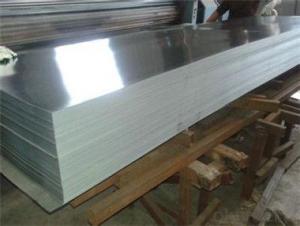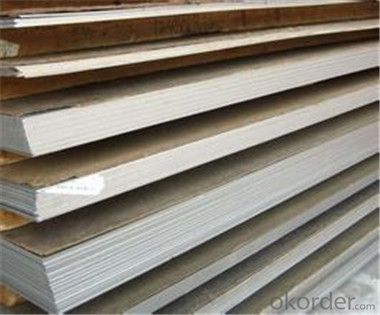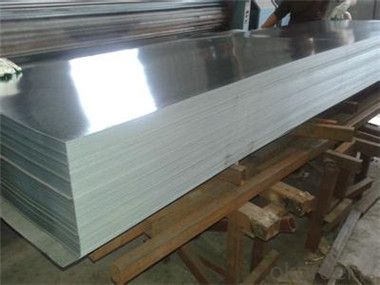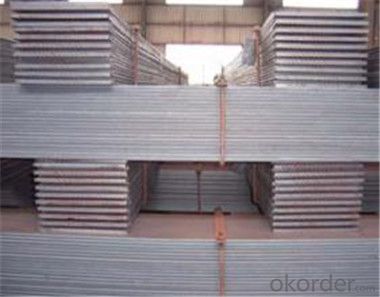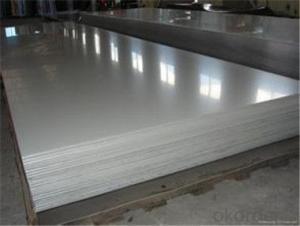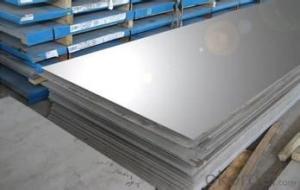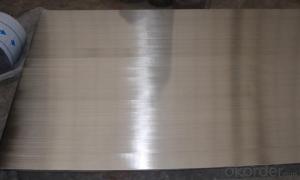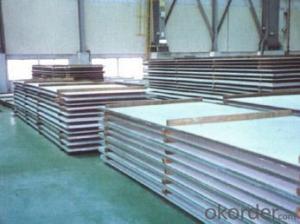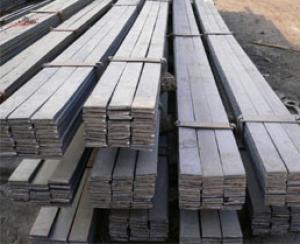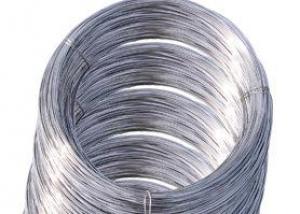Stainless Steel Sheet AISI 316 with Best Quality
- Loading Port:
- Tianjin
- Payment Terms:
- TT OR LC
- Min Order Qty:
- 50 m.t.
- Supply Capability:
- 45555555 m.t./month
OKorder Service Pledge
OKorder Financial Service
You Might Also Like
Specification
Description of stainless steel plate::
316L stainless steel containing molybdenum species, the steel containing molybdenum, the overall performance is better than steel 310 and 304 stainless steel, high temperature conditions.
Festures of stainless steel plate:
| Packaging Details: | standard packing to export 4 eye bands and 3 circumferential bands in steel, galvanized metal fluted rings on inner and outer edges |
| Delivery Detail: | 15-25 days after received your deposit or to your quantity |
Specifications of stainless steel plate:
Product Name | cr 1219x2438 stanless steel sheet 201 |
standared | JIS, AISI, ASTM, GB, DIN,SUS |
Thickness | 0.2mm~2.5mm |
Size | 1000*2000mm,1219*2438mm or as per customers' request |
Surface finish | 2B, BA, Hair Line, No.1,No.4, Mirror Finish |
Application | Kitchenware, decoration construction and building ornament, product parts manufacturing and stainless steel products tooling and so on |
Payment terms | T/T 30% for deposit, Balance against the copy of B/L; or L/C at sight |
Product Packing | wooden pallet |
Delivery time | within 15-20 working days after we got your 30% deposit |
Attention | FREE SAMPLES can be sent on request. |
Images of stainless steel plate:
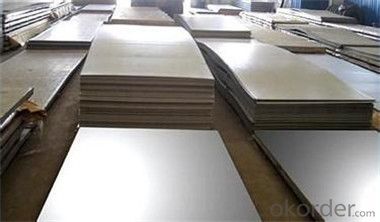
FAQ:
1. What is your package?
Packing situation: standard seaworthy packing or as customer required.
2. How long is the lead time?
Delivery time: 45 days after order confirmed.
3. What payment term do you accept?
Payment: T/T or L/C at sight.
- Q: Can steel wire rod be used in high-temperature applications?
- Steel wire rod can be used in high-temperature applications, but it is important to consider the specific type of steel used and the temperatures involved. Certain grades of steel, such as stainless steel or heat-resistant alloys, are specifically designed to withstand high temperatures without significant loss of strength or structural integrity. These types of steel are often used in industries such as aerospace, automotive, and power generation, where exposure to high temperatures is common. However, not all steel wire rods are suitable for high-temperature applications. Some lower-grade steels may experience a decrease in mechanical properties, such as tensile strength, ductility, and corrosion resistance, when exposed to elevated temperatures. It is crucial to consult the manufacturer's specifications or seek expert advice to determine if a particular steel wire rod is appropriate for the intended high-temperature environment. Additionally, other factors such as the operating conditions, duration of exposure, and presence of other corrosive elements or chemicals should be taken into account when considering the use of steel wire rod in high-temperature applications. Regular monitoring and maintenance may be necessary to ensure the continued performance and safety of the steel wire rod in such environments.
- Q: How are steel wire rods used in the manufacturing of strings for musical instruments?
- Musical instrument strings rely heavily on steel wire rods to provide strength, durability, and the ability to withstand tension. These rods serve as the core material for the inner structure of strings, ensuring their robustness. To craft musical instrument strings, steel wire rods undergo a series of meticulous processes. Initially, they are carefully chosen based on their desired characteristics, such as flexibility and tensile strength. Subsequently, these rods are drawn through a set of dies to reduce their diameter and increase their length, a process known as drawing. After drawing, the steel wire rods often go through additional steps to enhance their performance. These steps may include annealing, which entails subjecting the rods to specific temperatures and gradually cooling them to enhance flexibility and eliminate internal stresses. Furthermore, the rods might undergo surface treatments like electroplating or coating to prevent corrosion and improve playability. Once the steel wire rods have undergone the necessary processing, they are ready to be transformed into strings. Typically, the rods are wound tightly around a core material, such as nylon or gut, to achieve the desired thickness and tension for each string. This winding process ensures that the steel wire remains securely in place, providing the necessary strength and stability. Utilizing steel wire rods in the manufacturing of musical instrument strings offers numerous advantages. Steel produces a bright and clear tone, making it suitable for various instruments such as guitars, pianos, and violins. Additionally, these rods offer exceptional durability and resistance to breakage, enabling the strings to withstand the constant tension and impact of playing. In conclusion, steel wire rods hold a vital role in the manufacturing of musical instrument strings. Their strength, flexibility, and durability make them an ideal material for the inner structure of strings, while also contributing to the instrument's unique sound and playability.
- Q: How does the ductility of steel wire rod vary with different wire drawing processes?
- The ductility of steel wire rod can change depending on the wire drawing technique utilized. Wire drawing, a metalworking process in which a metal wire is pulled through a die to decrease its diameter and increase its length, is responsible for this variation. The ductility of the steel wire rod refers to its capacity to deform under tensile stress without fracturing. The ductility of the steel wire rod can be influenced by different wire drawing techniques due to several factors, including the degree of diameter reduction, the number of drawing passes, and the temperature employed during the process. Generally, as the wire's diameter decreases during wire drawing, the ductility of the steel wire rod increases. This is because reducing the diameter raises the dislocation density in the steel's crystal lattice, allowing for greater plastic deformation before fracture occurs. The number of drawing passes also has an impact on the ductility of the steel wire rod. Multiple drawing passes permit a more controlled reduction in diameter, resulting in a more even distribution of dislocations and an increase in ductility. Moreover, the temperature during the wire drawing process can affect the ductility of the steel wire rod. Higher temperatures can enhance ductility by reducing the steel's strength, allowing for more deformation before fracture. Nevertheless, excessive heat can have a negative impact on the steel's microstructure and reduce its ductility. To sum up, the ductility of steel wire rod can differ depending on the wire drawing technique employed. Factors such as the degree of diameter reduction, the number of drawing passes, and the temperature during the process all contribute to determining the final ductility of the wire.
- Q: How is steel wire rod used in the manufacturing of suspension components for automobiles?
- Steel wire rod is commonly used in the manufacturing of suspension components for automobiles due to its high strength and durability. It is typically formed and shaped into various suspension parts such as coil springs, stabilizer bars, and control arms. These components play a crucial role in providing stability, support, and smooth handling to the vehicle. The steel wire rod's properties allow it to withstand heavy loads and absorb shocks, making it an ideal material for suspension systems in automobiles.
- Q: How is steel wire rod used in the manufacturing of piano wires?
- Steel wire rod is used in the manufacturing of piano wires as it serves as the primary material for creating the high-quality and durable strings of a piano. The wire rod undergoes various processes such as drawing, annealing, and twisting to achieve the desired thickness, strength, and flexibility needed for producing piano wires.
- Q: What are the main components of a steel wire rod mill?
- A steel wire rod mill comprises several essential components: a reheating furnace, roughing mill, intermediate mill, finishing mill, cooling bed, and coiling machines. To prepare the raw material, typically billets or ingots, for rolling, it is necessary to heat them in the reheating furnace. This heating process serves to reduce brittleness and enhance plasticity. In the roughing mill, the heated material undergoes a series of rolling passes to decrease its thickness. This is achieved through the use of multiple stands of rolls. Following the roughing mill, the material progresses to the intermediate mill. Here, further reduction in thickness occurs, and the surface quality of the wire rod is improved. The finishing mill represents the final stage of the rolling process. It is comprised of multiple stands of rolls that give the wire rod its ultimate dimensions and surface finish. This mill plays a pivotal role in attaining the desired mechanical properties and dimensional accuracy of the wire rod. Once the wire rod reaches the desired shape and size, it is transferred to the cooling bed. This bed allows for gradual cooling of the wire rod, preventing any deformation or cracking caused by the high temperatures from the rolling process. Finally, the coiling machines are employed to coil the wire rod into spools or coils, facilitating its transportation and storage. In summary, these key components collaborate within a steel wire rod mill to convert raw materials into top-quality wire rods suitable for diverse industries such as construction, automotive, and manufacturing.
- Q: How is steel wire rod used in the manufacturing of wire rope clips?
- Steel wire rod is used in the manufacturing of wire rope clips as the main material for creating the clips themselves. The wire rod is shaped and formed into the specific design of the clip, ensuring strength and durability. Additionally, the steel wire rod undergoes various processes such as heat treatment, galvanization, or coating to enhance its corrosion resistance properties, making it suitable for use in wire rope clips that are exposed to harsh environments.
- Q: What are the common production processes for nitrogen-coated steel wire rod?
- The common production processes for nitrogen-coated steel wire rod typically include wire drawing, cleaning, coating with nitrogen, and annealing. The wire drawing process involves reducing the diameter of the wire rod through a series of dies. After wire drawing, the wire rod is cleaned to remove any impurities. Next, a nitrogen coating is applied to the wire rod to enhance its corrosion resistance and mechanical properties. Finally, the coated wire rod is annealed to relieve internal stresses and further improve its strength and flexibility.
- Q: How are steel wire rods used in the production of wire ropes for cranes?
- Steel wire rods are a crucial component in the production of wire ropes for cranes. These rods serve as the raw material for the wire rope manufacturing process. To begin with, the steel wire rods are carefully selected based on their mechanical properties, such as strength and durability. The rods go through a series of processes, including cleaning, heating, and drawing, to convert them into wire strands. Once the wire strands are formed, they are wound together to create the wire rope. This process involves twisting multiple strands around a central core, usually made of fiber or steel. The wire strands are arranged in a helical pattern, which enhances the strength and flexibility of the wire rope. The steel wire rods used in the production of wire ropes for cranes are specifically chosen for their high tensile strength. This ensures that the wire ropes have the ability to withstand heavy loads and extreme working conditions. The strength of the steel wire rods directly impacts the overall strength and safety of the wire ropes. Additionally, the steel wire rods undergo various quality control measures during the manufacturing process to ensure their reliability and consistency. These measures include testing for tensile strength, breaking load, and other performance parameters. Once the wire ropes are manufactured using the steel wire rods, they are then used in cranes for a variety of applications. Wire ropes are essential for lifting and moving heavy loads, providing stability and control during crane operations. They play a vital role in safely and efficiently lifting, lowering, and suspending loads in various construction, industrial, and maritime settings. Overall, steel wire rods are integral to the production of wire ropes for cranes, as they provide the necessary strength, durability, and reliability required in demanding working environments.
- Q: What are the main factors affecting the market trends of steel wire rod?
- The main factors affecting the market trends of steel wire rod include demand from industries such as construction, automotive, and manufacturing, global economic conditions, raw material prices and availability, technological advancements, government policies and regulations, and competition within the industry.
Send your message to us
Stainless Steel Sheet AISI 316 with Best Quality
- Loading Port:
- Tianjin
- Payment Terms:
- TT OR LC
- Min Order Qty:
- 50 m.t.
- Supply Capability:
- 45555555 m.t./month
OKorder Service Pledge
OKorder Financial Service
Similar products
Hot products
Hot Searches
Related keywords

